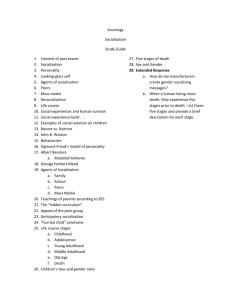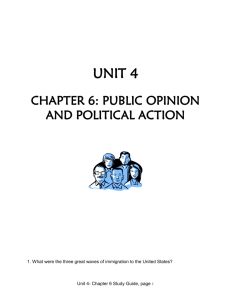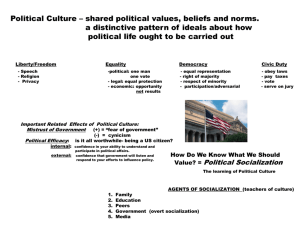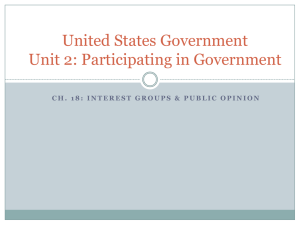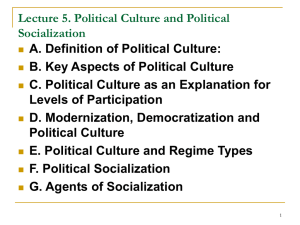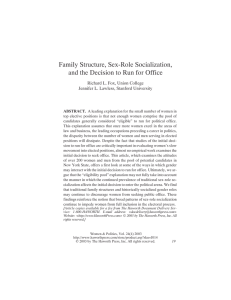public opinion - APGovernment
advertisement
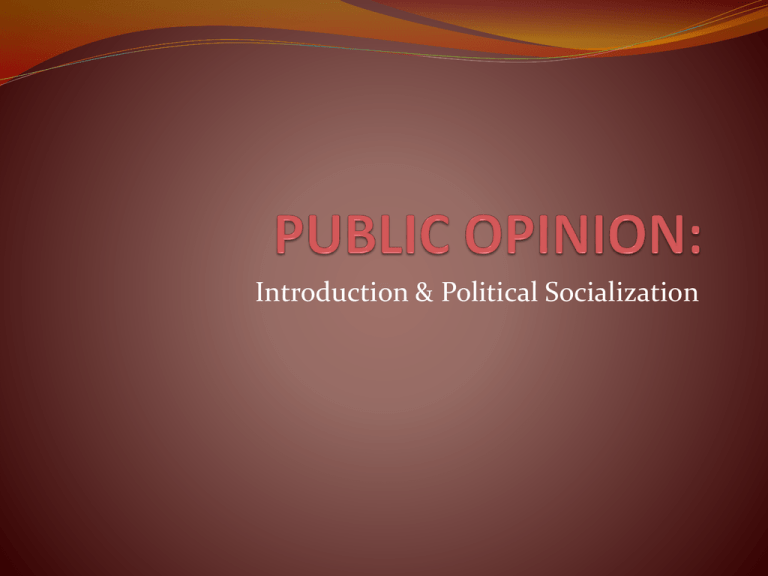
Introduction & Political Socialization CHARACTERISTICS OF PUBLIC OPINION Public attitudes toward a given government policy can vary over time, often dramatically Public opinion places boundaries on allowable types of public policy If asked by pollsters, citizens are willing to register opinions on matters outside their expertise CHARACTERISTICS OF PUBLIC OPINION Governments tend to respond to public opinion Example – death penalty Majoritarian politics The government sometimes does not do what the public wants Example – Court declared school prayer unconstitutional Pluralist politics WHAT IS PUBLIC OPINION??? Collected attitudes of citizens concerning a given issue or questions Polling is a relatively new feature of American life Before polling, most observers used newspaper stories, politicians’ speeches and voting in order to determine public opinion PUBLIC OPINION & THE FRAMERS Public opinion during the Revolution 40% supported 20% opposed 40% neutral Public opinion was built into our government by a directly elected House of Representatives This would reflect public opinion on crucial issues like taxes and spending DISTRIBUTION OF PUBLIC OPINION: SKEWED DISTRIBUTION Asymmetrical but generally bell shaped distribution Most frequent response lies off to one side Indicates homogeneity of opinion RIGHT – Opinions on Death Penalty 80 70 60 50 40 30 20 10 0 Favor Don't Know Oppose DISTRIBUTION OF PUBLIC OPINION: BIMODAL DISTRIBUTION Distribution that shows two responses being chosen about as frequently as each other Provides potential for political conflict RIGHT: Position on Gay Marriage 50 45 40 35 30 25 20 15 10 5 0 Favor Don't Know Oppose DISTRIBUTION OF PUBLIC OPINION: NORMAL DISTRIBUTION Symmetrical bell-shaped distribution centered on a single mode, or frequent response Public tends to support a moderate government policy It will tolerate policies that lean slightly left or right RIGHT – Ideology Self- Placement 30 25 20 15 10 5 0Extrem ely Liberal Moderate Extrem ely Conservative STABLE DISTRIBUTION Distribution that shows little change over time When different questions on the same issue produce similar distribution of opinions, underlying attitudes are stable When the same question produces significantly different responses over time, a shift in public opinion has probably occured WHAT MAKES THESE QUESTIONS BIASED? “Are you in favor of killing babies?” in an abortion survey. “Would you say that Bill Clinton clobbered Bob Dole in the last election?” in a postelection poll. “Do you like the President?” in a presidential approval rating. “Whom did you vote for in the last election?” to assess partisan affiliation. THINK BACK. . . What is your earliest memory of a president? When did you first learn about political parties? Do you identify with a particular political party? How did you decide to do so? WHAT IS POLITICAL SOCIALIZATION?? Complex process by which people acquire their political values Most people are exposed to the same sources of influence (agents of socialization) Family School Community Peers Television AGENTS OF EARLY SOCIALIZATION: FAMILY Most important agent of political socialization Children tend to learn their social, moral, religious economic and political values from their parents Parents who are interested in politics and public affairs tend to influence their children to become more politically aware Children tend to identify with the political party of their parents If they switch, they likely identify themselves as Independent THESE AREN’T YOUR GRANDFATHER’S POLITICS!! Since the 1950’s, the number of people willing to identify themselves as Democrat or Republican has decreased Children are less likely to share their parent’s attitudes on issues involving civil liberties and racial issues. Are you pondering what I’m pondering. . . Why might children and parents differ on ideas of civil liberties and race? AGENTS OF EARLY SOCIALIZATION: ELEMENTARY SCHOOL Prepare children to accept the social order Introduction to authority figures outside the family (i.e. principal, teacher, etc) Students learn the nation’s slogans and symbols Pledge of Allegiance, flag, holidays Stress the norms of group behavior and democratic decision making Respecting each other’s opinion Stress on political equality AGENTS OF EARLY SOCIALIZATION: SECONDARY SCHOOL Teachers challenge students to think critically about American government and politics Students become more politically aware of the process and prominent participants in the political process Teachers try to build children’s trust in the political process External factors can oftentimes erode that trust AGENTS OF SOCIALIZTION: COMMUNITY & PEERS Community – people of all ages with whom you come in contact because of proximity Homogenous communities can exert pressure on children and adults to conform to the dominant attitude of the community Peers – friends, classmates, coworkers Peers can provide a defense against community pressure HERE’S A THOUGHT?? As Americans, are we duped by the media into thinking one way or another??

